Eight audio technologies and audio gadgets that will get into the TECnology hall of fame in 2019
Fourteen years ago, the TEC Awards organizers - awards for achievements in the field of audio technologies - established the TECnology Hall of Fame. The first to include such inventions as the Edison cylinder and the gramophone. Since then, the list is updated annually.
Representatives of the award have already announced the "novelties" of 2019. Among them - a modular synthesizer Moog and anechoic chamber. About what makes these things special, we will tell in the material.
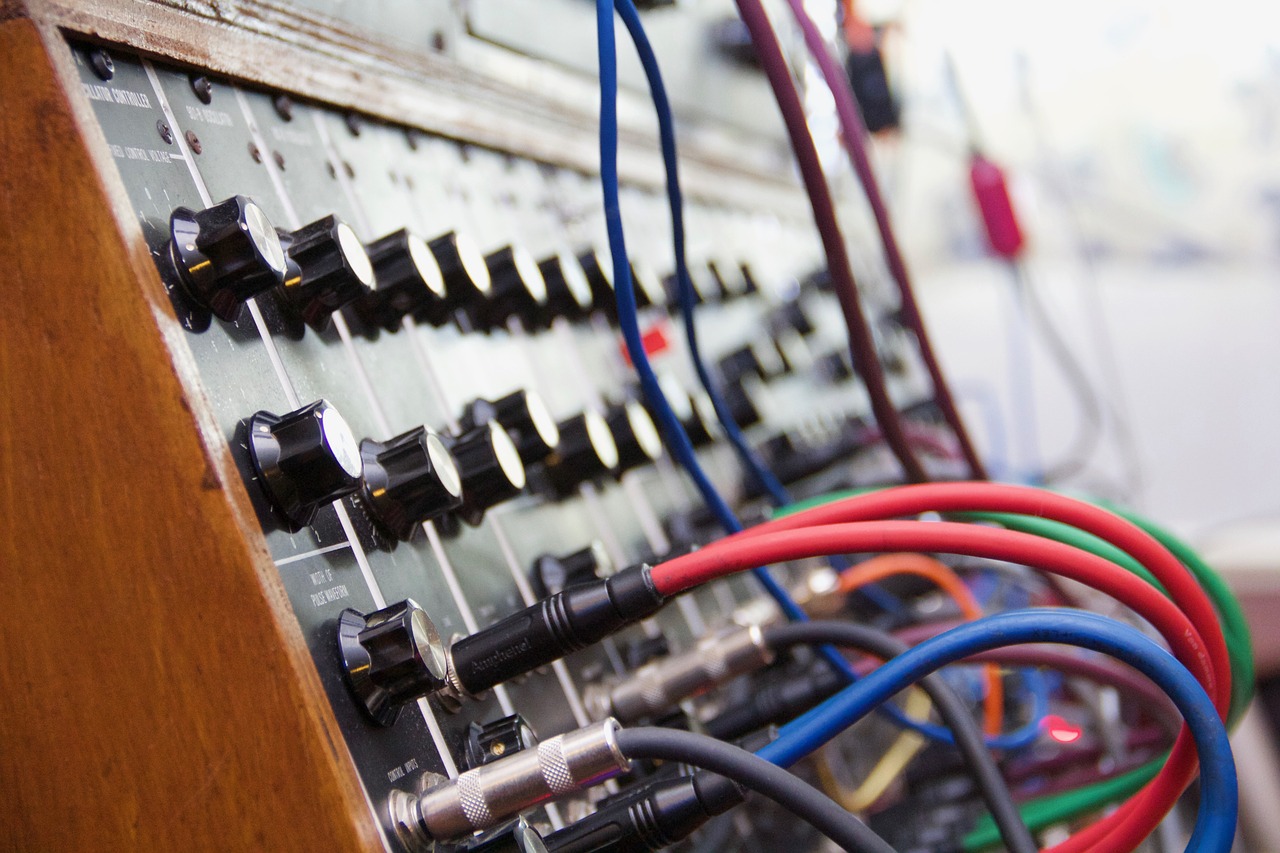
Photo of Max Pixel / PD / Moog Synthesizer
')
The first room, completely absorbing sound waves, was built in 1943 to test military audio systems. The project was led by the head of the Harvard Electroacoustic Laboratory, Leo Beranek (Leo Beranek). After the end of World War II, the sound-absorbing fiberglass coating developed by the scientist was declassified and has since been widely used for acoustic modification of premises.
In 1951, composer John Cage visited the Harvard anechoic chamber. He wanted to experience absolute silence, but instead he heard the sounds that his circulatory system made. John realized that a person observing silence, apart from his will, turns into a source of sound and subsequently created his most famous work - the play “ 4'33 '' ”. Throughout the entry, the ensemble members do not play musical instruments.
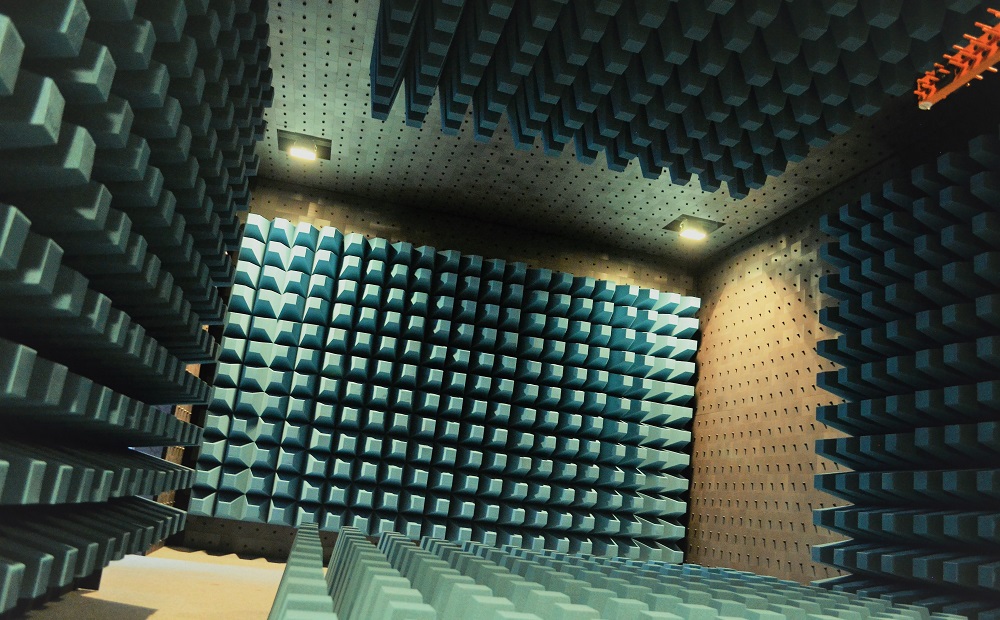
Photo Mihaelawojcik / CC BY
There is a myth that people can not be in an anechoic chamber for more than 45 minutes - otherwise they lose their orientation in space and begin to see hallucinations. This is not true - some people feel comfortable in an anechoic chamber even longer.
We talked more about this earlier .
The legendary ribbon microphone manufactured by Beyerdynamic since 1952. A distinctive feature of the M160 is its narrow radiation pattern, not typical of other models of ribbon microphones. For this reason, it "captures" less noise from the environment. All this makes the microphone ideal for recording drums.
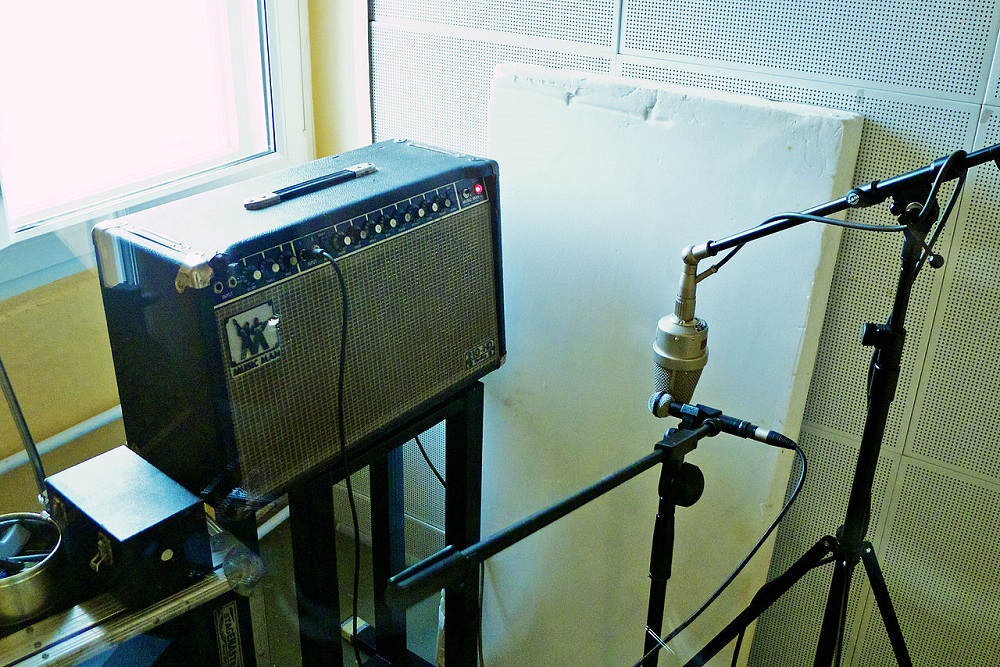
Photo clusternote / CC BY / Microphones Neumann M49 and Beyerdynamic M160 (foreground)
Beyerdynamic M160 played an important role in the creation of John Bonham's corporate sound during the recording of the fourth studio album, Led Zeppelin IV. And the famous shock introduction to When The Levee Breaks - one of the tracks from the album - has completely healed its own life. He was sampled by a variety of performers : from Bjork and Depeche Mode to Eminem and Dr. Dre.
Electret condenser microphones are known for their compactness and practicality. They are cheaper than other capacitor models, and their size can be only a few centimeters. The first electret microphone was invented by Bell Labs engineers James West (James West) and Gerhard Sessler in 1962.
Traditional condenser microphones need an external source of polarizing voltage. In electret microphones, this voltage is provided by a special Teflon plate charged during the assembly of the device. The remaining electronic components of the microphone are powered by a built-in battery.
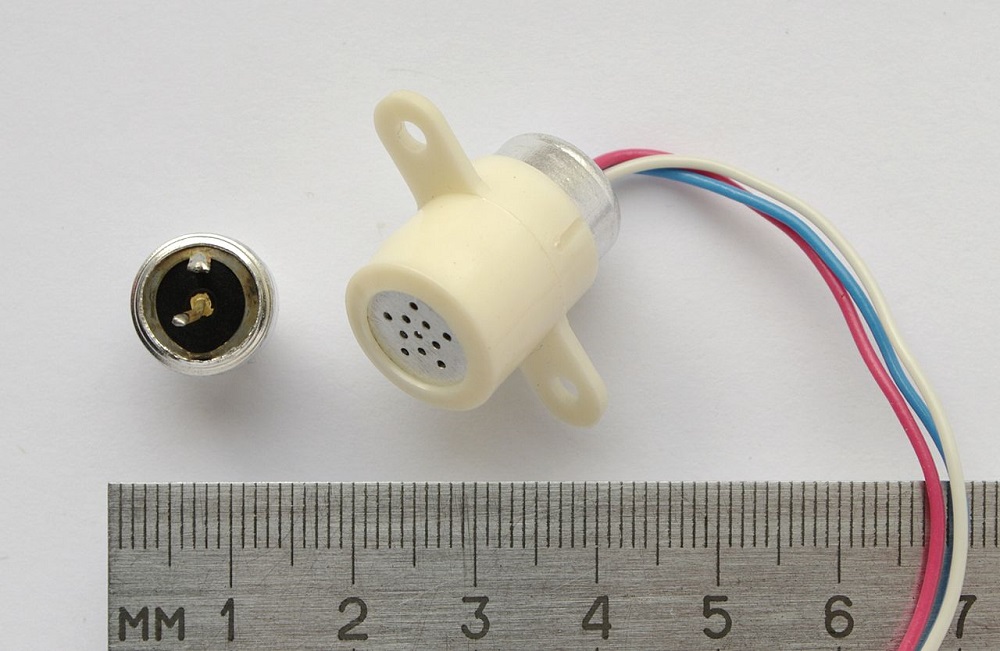
Photo Kae / CC BY-SA
The invention of the West and Sessler is used everywhere: in children's monitors and smartphones, in voice recorders and hearing aids. According to the National Inventors Hall of Fame , more than 90% of all microphones in the world are electret.
A modular synthesizer consists of independent audio components connected to a single power bus. Audio sources and transducers can be connected with short audio cables in any order, which allows you to synthesize a wide range of tones.
The idea of a modular synthesizer first appeared in the late 1950s with the engineer Harald Bode. In 1960, he demonstrated a prototype at the AES (Audio Engineering Society) conference. The event was attended by inventor Robert Moog, who was inspired by Harald's vision. Four years later, Robert introduced his Moog Modular.
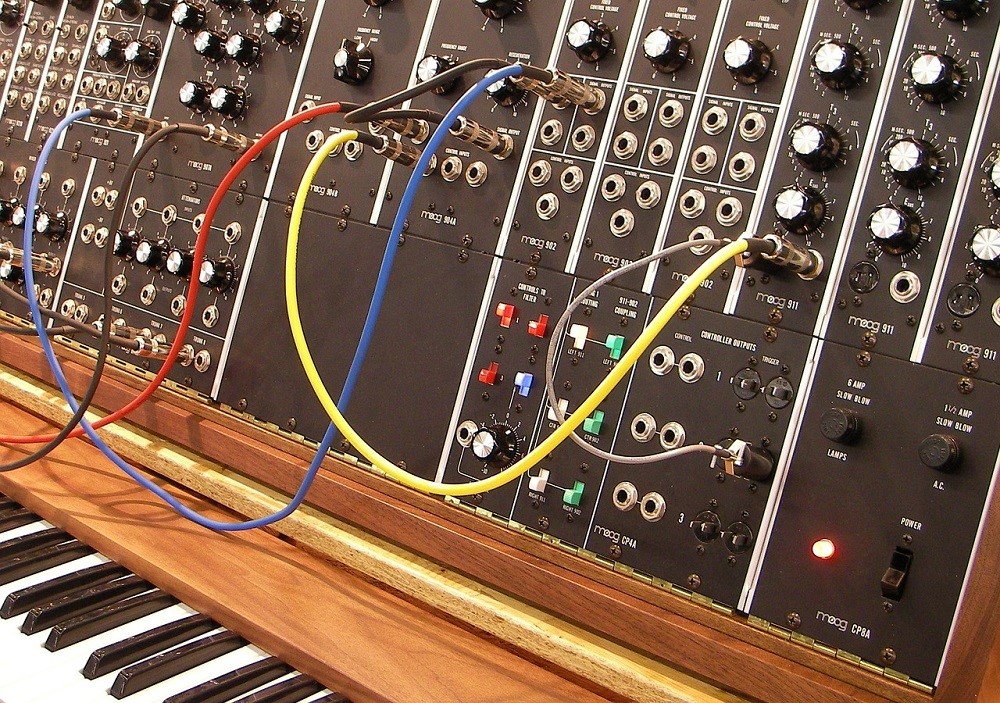
Photo kpr2 / PD
For a long time, Moog Modular was not in demand. In a desperate attempt to change it, the company spent the last money to rent a pavilion at the 1967 Monterey Music Festival . This move bore fruit - Moog was ordered by representatives of The Beatles, The Rolling Stones and other popular groups. Later, the instrument was played on the soundtrack of “A Clockwork Orange” and on the album “The Beatles Abbey Road”.
Soon interest in modular instruments was asleep, and Robert Moog began to develop compact synthesizers without open connectors and hanging wires. But the modular Moog still has its adherents. Only in 2014, the company re-released a small batch of instruments in honor of the 50th anniversary of the synthesizer.
RADAR, or Random Access Digital Audio Recorder, is the world's first recording system that supports 24-channel digital recording on hard drives. She was released in 1994.
RADAR I was called one of the best digital products on the market - users praised the quality of the recording and the convenience of the interface . Therefore, the system sold well. But with the development of computer hardware, integrated digital recording solutions have lost popularity.
Despite this, the company maintains its competitiveness. The last iteration of RADAR supports popular DAWs , like Pro Tools, and in the list of users of the system today there are such celebrities as U2, Neil Young and a number of media companies.
This system, released in 1991, allows sound engineers to monitor the distortion of sound in the hall. Its creator is John Mayer. SIM algorithms analyze audio in real time and suggest how to get rid of the distortion caused by the features of the acoustic design of the room. Taking this information into account, the sound engineer makes adjustments to the equipment settings.
The Millennia Media HV-3 is a microphone preamplifier, first released in 1992. The device's inventor, John LaGrou, wanted to create the most neutral preamp that would not color the sound of acoustic instruments.
HV-3s are used to record instrumental audio libraries, such as the Vienna Symphonic Library and Paiste Soundroom collections. Also preamplifier use the creators of sound effects for Hollywood movies.
Sound engineer Frank Serafine, who worked on Star Trek: The Movie and Tron using HV-3, recorded a collection of movie samples. He said that the device makes it possible to achieve the most natural sound.
VerTec is a linear acoustic array for concerts and other public events. The system was created in 2000. JBL was confident in the success of VerTec and presented the technology for the first time at a mass congress of the American Democratic Party.
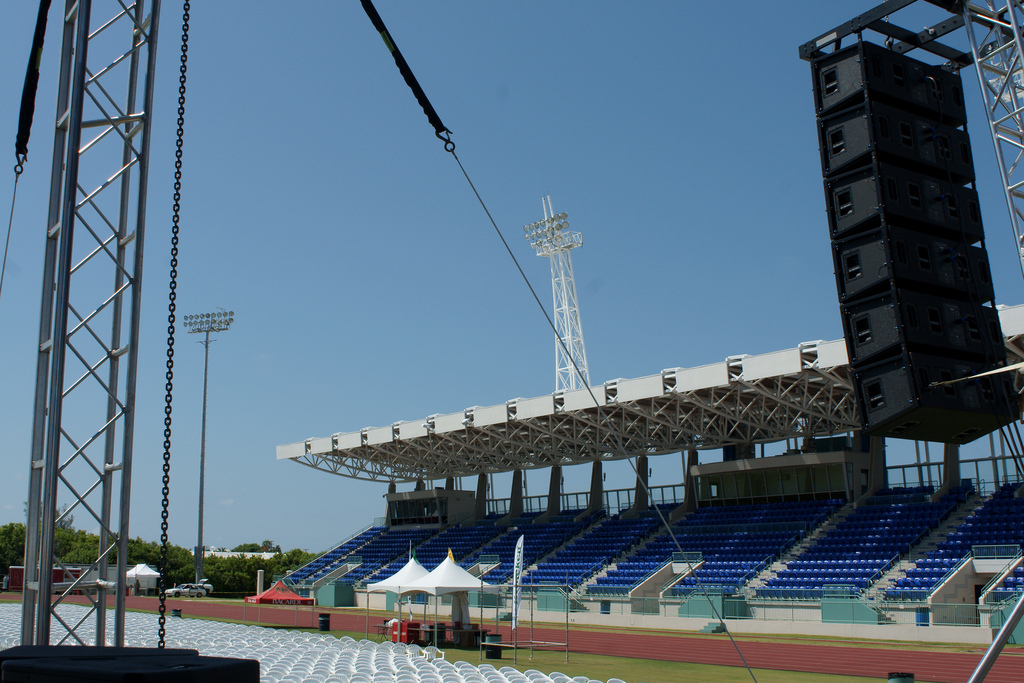
Photo sergio_leenen / CC BY-ND
The VerTec sound “concentrates” on the area of the hall in which the audience is located. In an interview with Billboard, JBL President compared the sound of VerTec with a laser beam that illuminates the space. Sound engineers noted another difference between the system and competitors' equipment - low weight. This simplified the installation and deployment of VerTec. In addition, the system was supplied with a program for calculating the effective location of the speakers and adjusting their sound.
These benefits made VerTec popular. Already in 2002, the arrays were played in the NFL finals, at the Grammy Awards and the opening ceremony of the FIFA World Cup. The system is used to this day.
More about speaker systems and audio gadgets in our Telegram channel:
 How to send sound to the listener
How to send sound to the listener
 What to change in the room to improve the sound of the audio system
What to change in the room to improve the sound of the audio system
 Brand history: Sennheiser
Brand history: Sennheiser
We have opened a New Year sale with discounts up to 75%. The action involves a variety of categories: from portable to professional audio.
Representatives of the award have already announced the "novelties" of 2019. Among them - a modular synthesizer Moog and anechoic chamber. About what makes these things special, we will tell in the material.

Photo of Max Pixel / PD / Moog Synthesizer
')
Anechoic chamber
The first room, completely absorbing sound waves, was built in 1943 to test military audio systems. The project was led by the head of the Harvard Electroacoustic Laboratory, Leo Beranek (Leo Beranek). After the end of World War II, the sound-absorbing fiberglass coating developed by the scientist was declassified and has since been widely used for acoustic modification of premises.
In 1951, composer John Cage visited the Harvard anechoic chamber. He wanted to experience absolute silence, but instead he heard the sounds that his circulatory system made. John realized that a person observing silence, apart from his will, turns into a source of sound and subsequently created his most famous work - the play “ 4'33 '' ”. Throughout the entry, the ensemble members do not play musical instruments.

Photo Mihaelawojcik / CC BY
There is a myth that people can not be in an anechoic chamber for more than 45 minutes - otherwise they lose their orientation in space and begin to see hallucinations. This is not true - some people feel comfortable in an anechoic chamber even longer.
We talked more about this earlier .
Beyerdynamic M160 microphone
The legendary ribbon microphone manufactured by Beyerdynamic since 1952. A distinctive feature of the M160 is its narrow radiation pattern, not typical of other models of ribbon microphones. For this reason, it "captures" less noise from the environment. All this makes the microphone ideal for recording drums.

Photo clusternote / CC BY / Microphones Neumann M49 and Beyerdynamic M160 (foreground)
Beyerdynamic M160 played an important role in the creation of John Bonham's corporate sound during the recording of the fourth studio album, Led Zeppelin IV. And the famous shock introduction to When The Levee Breaks - one of the tracks from the album - has completely healed its own life. He was sampled by a variety of performers : from Bjork and Depeche Mode to Eminem and Dr. Dre.
Electret microphone
Electret condenser microphones are known for their compactness and practicality. They are cheaper than other capacitor models, and their size can be only a few centimeters. The first electret microphone was invented by Bell Labs engineers James West (James West) and Gerhard Sessler in 1962.
Traditional condenser microphones need an external source of polarizing voltage. In electret microphones, this voltage is provided by a special Teflon plate charged during the assembly of the device. The remaining electronic components of the microphone are powered by a built-in battery.

Photo Kae / CC BY-SA
The invention of the West and Sessler is used everywhere: in children's monitors and smartphones, in voice recorders and hearing aids. According to the National Inventors Hall of Fame , more than 90% of all microphones in the world are electret.
Modular synthesizer Moog
A modular synthesizer consists of independent audio components connected to a single power bus. Audio sources and transducers can be connected with short audio cables in any order, which allows you to synthesize a wide range of tones.
The idea of a modular synthesizer first appeared in the late 1950s with the engineer Harald Bode. In 1960, he demonstrated a prototype at the AES (Audio Engineering Society) conference. The event was attended by inventor Robert Moog, who was inspired by Harald's vision. Four years later, Robert introduced his Moog Modular.

Photo kpr2 / PD
For a long time, Moog Modular was not in demand. In a desperate attempt to change it, the company spent the last money to rent a pavilion at the 1967 Monterey Music Festival . This move bore fruit - Moog was ordered by representatives of The Beatles, The Rolling Stones and other popular groups. Later, the instrument was played on the soundtrack of “A Clockwork Orange” and on the album “The Beatles Abbey Road”.
Soon interest in modular instruments was asleep, and Robert Moog began to develop compact synthesizers without open connectors and hanging wires. But the modular Moog still has its adherents. Only in 2014, the company re-released a small batch of instruments in honor of the 50th anniversary of the synthesizer.
iZ Technology RADAR
RADAR, or Random Access Digital Audio Recorder, is the world's first recording system that supports 24-channel digital recording on hard drives. She was released in 1994.
RADAR I was called one of the best digital products on the market - users praised the quality of the recording and the convenience of the interface . Therefore, the system sold well. But with the development of computer hardware, integrated digital recording solutions have lost popularity.
Despite this, the company maintains its competitiveness. The last iteration of RADAR supports popular DAWs , like Pro Tools, and in the list of users of the system today there are such celebrities as U2, Neil Young and a number of media companies.
Meyer Source Independent Measurement System II (SIM)
This system, released in 1991, allows sound engineers to monitor the distortion of sound in the hall. Its creator is John Mayer. SIM algorithms analyze audio in real time and suggest how to get rid of the distortion caused by the features of the acoustic design of the room. Taking this information into account, the sound engineer makes adjustments to the equipment settings.
SIM technologies are used in concert halls around the world. They are set up at the Vienna Philharmonic, the Moscow House of Music and the New World Center in Miami.
Millennia Media HV-3
The Millennia Media HV-3 is a microphone preamplifier, first released in 1992. The device's inventor, John LaGrou, wanted to create the most neutral preamp that would not color the sound of acoustic instruments.
HV-3s are used to record instrumental audio libraries, such as the Vienna Symphonic Library and Paiste Soundroom collections. Also preamplifier use the creators of sound effects for Hollywood movies.
Sound engineer Frank Serafine, who worked on Star Trek: The Movie and Tron using HV-3, recorded a collection of movie samples. He said that the device makes it possible to achieve the most natural sound.
JBL Professional VerTec
VerTec is a linear acoustic array for concerts and other public events. The system was created in 2000. JBL was confident in the success of VerTec and presented the technology for the first time at a mass congress of the American Democratic Party.

Photo sergio_leenen / CC BY-ND
The VerTec sound “concentrates” on the area of the hall in which the audience is located. In an interview with Billboard, JBL President compared the sound of VerTec with a laser beam that illuminates the space. Sound engineers noted another difference between the system and competitors' equipment - low weight. This simplified the installation and deployment of VerTec. In addition, the system was supplied with a program for calculating the effective location of the speakers and adjusting their sound.
These benefits made VerTec popular. Already in 2002, the arrays were played in the NFL finals, at the Grammy Awards and the opening ceremony of the FIFA World Cup. The system is used to this day.
More about speaker systems and audio gadgets in our Telegram channel:
 How to send sound to the listener
How to send sound to the listener  What to change in the room to improve the sound of the audio system
What to change in the room to improve the sound of the audio system  Brand history: Sennheiser
Brand history: SennheiserWe have opened a New Year sale with discounts up to 75%. The action involves a variety of categories: from portable to professional audio.
Source: https://habr.com/ru/post/433954/
All Articles